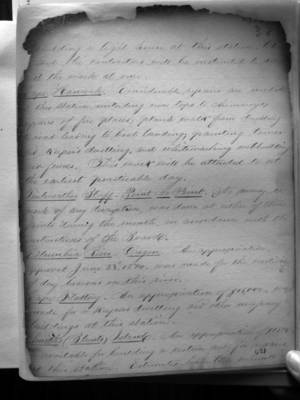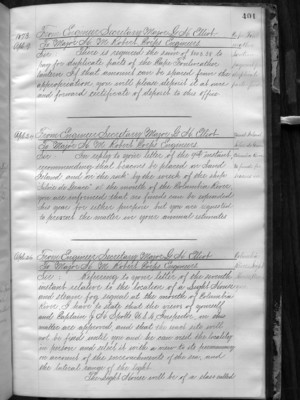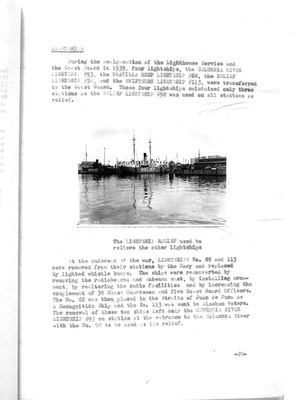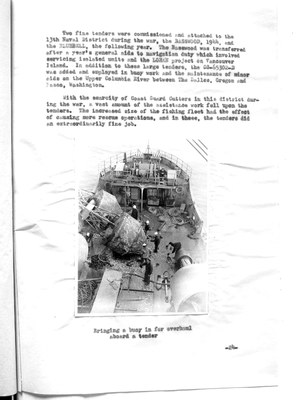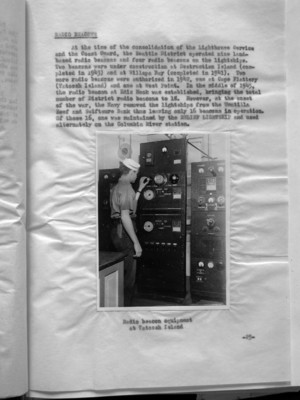Pages That Mention Columbia River
Vol 348 Engineer Reports 13th Dist. 1873 and 1874 CF Exhibted YB Discontinued
26
building a light house at this station. The ??? received the contractors will be instructed to ??? with the work at once. Cape Hancock. Considerable repairs are need at this station, including iron tops to chimneys; repairs of fire places; plank wall from dwelling to road leading to boat landing; painting tower and Keeper’s dwelling, and whitewashing outbuilding, and fences. This work will be attended to at the earliest practicable day. Foulweather Bluff-Point No Point. No survey, or work of any description, was don’t at either of these points during the month, in accordance with the instructions of the Board. Columbia River – Oregon. An appropriation approved June 23rd, 1874, was made for the erection of day beacons on this river. Cape Flattery. An appropriation of $1500 is available for building a custom and for repairs at this station. Lanitis??? (Blunts) Island. An appropriation of $1500 is available for building as cistern and for repairs at this station. Estimates have been submitted.
1870-73 Lighthouse Board Annual Reports
47
1873 Apl. 9.
From Engineer Secretary Major G. H. Elliot. To Major H. M. Robert. Corps Engineers.
Sir: There is required the sum of $803.58 to pay for duplicate parts of the Cape Foulweather lantern. If that amount can be spared from the appropriation, you will please deposit it at once and forward certificate of deposit to this office.
_________________________________________________
Apl. 24.
From Engineer Secretary Major G. H. Elliot. To Major H. M. Robert. Corps Engineers.
Sir: In reply to your letter of the 9th instant, recommending that beacons be placed on Sand Island, and on "the rock" by the wreck of the ship "Silvie de Grace" at the mouth of the Columbia River, you are informed that no funds can be expended this year for either purpose, but you are requested to present the matter in your annual estimates.
_________________________________________________
Apl. 26.
From Engineer Secretary Major G. H. Elliot. TO Major H. M. Robert Corps Engineers.
Sir: Referring to your letter of the seventh instant relative to the location of a Light House and steam fog signal at the mouth of Columbia River, I have to state that the views of yourself and Captain J. H. Spotts, U.S.A. Inspector, on this matter are approved, and that the exact site will not be fixed until you and he can visit the locality in person and select it with a view to its permanency on account of the encroachments of the sea, and the lateral range of the light. The Light House will be of a class called
Coast Guard District narrative histories 1945
5
During the amalgamation of the Lighthouse Service and the Coast Guard in 1939, four lightships, the COLUMBIA RIVER LIGHTSHIP 393, the UMATILLA REEF LIGHTSHIP #88, the RELIEF LIGHTSHIP #92, and the SWIFTSURE LIGHTSHIP #113, were transferred to the Coast Guard. These four lightships maintained only three stations as the RELIEF LIGHTSHIP #92 was used on all stations as relief.
(Photo of Relief Lightship displayed with caption below)
The LIGHTSHIP RELIEF used to relieve the other lighthships
At the outbreak of the war, LIGHTSHIPS No. 88 and 113 were removed from their stations by the Navy and replaced by lighted whistle buoys. the ships were reconverted by removing the radiobeacon and antenna mast, by installing armament, by realtering the radio facilities and by increasing the complement of 30 Coast Guardmen and five Coast Guard Officers. The No. 88 was then placed in the Straits of Juan de Fuca as a Recognition Ship and the No. 113 was sent to Alaskan Waters. The removal of these two ships left only the COLUMBIA RIVER LIGHTSHIP #93 on station at the entrance to the Columbia River with the No. 92 to be used as its relief.
-22-
7
Two fine tenders were commissioned and attached to the 13th Naval District during the war, the BASSWOOD, 1944, and the BLUEBELL, the following year. The Basswood was transferred after a year's general aide to navigation duty which involved servicing the isolated units and the LORAN project on Vancouver Island. In addition to these large tenders, the CO-65302-D was added and employed in buoy work and the maintenance of minor aids on the Upper Columbia River between The Dalles, Oregon and Pasco, Washington.
With the scarcity of Coast Guard Cutters in this district during the war, a vast amount of the assistance work fell upon the tenders. The increased size of the fishing fleet had the effect of causing more rescue operations, and in these, the tenders did an extraordinarily fine job.
(Photo inserted here)
Bringing a buoy in for overhaul aboard a tender
-24-
8
At the time of the consolidation of the Lighthouse Service and the Coast Guard, the Seattle District operated nine land-based radio beacons and four radio beacons on the lightships. Two beacons were under construction at Destruction Island (completed in 1943) and at Willapa Bay (completed in 1941). Two more radio beacons were authorized in 1942, one at Cape Flattery (Tatoosh Island) and one at West Point. In the middle of 1945, the radio beacon at Ediz Hook was established, bringing the total number of District radio beacons to 18. However, at the onset of the war, the Navy removed the lightships from the Umatilla Reef and Swiftsure Bank thus leaving only 16 beacons in operation. Of these 16, one was maintained by the RELIEF LIGHTSHIP and used alternatively on the Columbia River station.
(Photo inserted here)
Radio beacon equipment at Tatoosh Island
-25-
